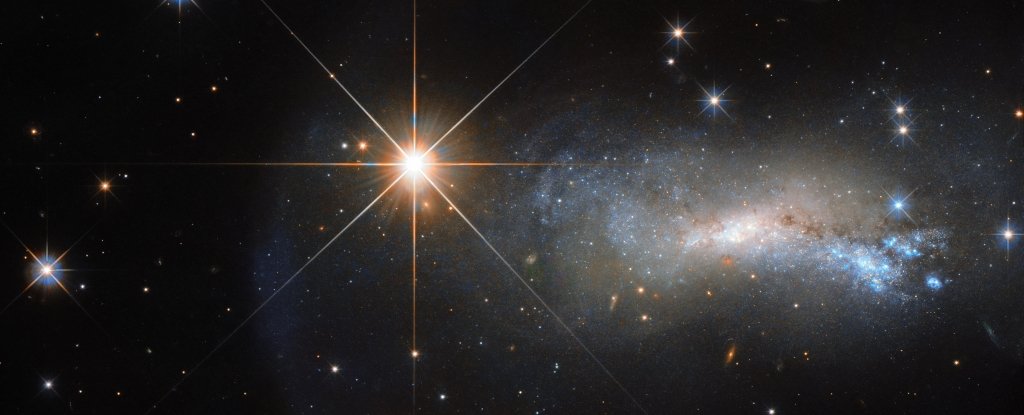
When we look at intergalactic space, evidence for dark matter is everywhere. It is in the rotation of galaxies, which cannot be explained by observable matter alone. It is in the way galaxies cluster together and the path of light as it travels through the Universe. We can’t see dark matter directly, but the effects it has on other objects have allowed us to map it quite comprehensively at large scales.
However, closer to home, actually within the Milky Way galaxy, and on subgalactic scales, the effects of dark matter are much smaller, and therefore much more difficult to map. But a new technique could finally discover where the dark matter of the Milky Way is hiding, by looking for a telltale warp in starlight as dark matter passes in front of them.
Dark matter is one of the most puzzling phenomena in the cosmos. We can’t detect it directly, so we don’t know what it is, but we do know that the amount of gravity in the Universe cannot be explained by observable normal matter, what we call baryonic matter, alone.
In the 1930s, astronomer Fritz Zwicky discovered that if the galaxies in the Coma cluster were held together by only normal matter, their rotational speed would exceed the escape velocity for objects within them. If these galaxies only consisted of baryonic matter, they would blow apart.
Something was creating extra gravity. We don’t know what that something is, that’s why we call it dark matter. Since then, the effects of dark matter have been observed in other ways, and cosmologists estimate that it represents about 85 percent of matter in the Universe.
One of those effects is the gravitational lens. According to the theory of general relativity, the mass curves space-time around it. For smaller objects, the observable effect of this is negligible, but for truly massive objects, for example, a group of galaxies, the curvature of space-time is much more pronounced, resulting in a curved path of light to as you travel through that region.
![]() Gravitational lenses. (NASA, ESA and L. Calçada)
Gravitational lenses. (NASA, ESA and L. Calçada)
In their new article, a team of researchers led by theoretical physicist Siddharth Mishra-Sharma of New York University proposes a framework for detecting gravitational lenses in individual stars in the Milky Way, in order to detect local dark matter.
When dark matter passes in front of a star, it should, in theory, alter the brightness of the star in such a way that the star appears to move. This has been predicted for decades, and is called a weak astrometric gravitational lens (astrometry is the study of the motion of stars), but the effect is so small that detecting it is an inversely proportional challenge.
Mishra-Sharma and colleagues propose that the weak astrometric gravitational lens may be detectable not in individual stars, but in groups.
“In this article, we propose a new technique to characterize the population properties of the galactic substructure through its collective lens effect on distant sources,” they wrote in their article.
“We show that, with astrometric observations in the near future, it is possible to statistically detect populations of cold dark matter subhalos, compact objects, as well as density fluctuations caused by scalar field dark matter.”
With highly accurate astrometric observations, the team framework would allow astronomers to infer the presence of dark matter by analyzing the distributions of the velocities and accelerations of stars and galaxies. They also applied their technique to a number of simulated scenarios, and found that these distributions vary by type of dark matter, so the framework could also help validate dark matter models.
And they discovered that the Sun’s orbit around the galactic center would introduce an asymmetry in the distributions, which could help separate the astrometric signal from weak gravitational lenses from noise.
The most complete astrometric catalog we currently have is from the European Space Agency’s Gaia satellite, an ongoing project to map the Milky Way in three dimensions with the highest precision yet. The team attempted to apply their framework to Gaia’s data and found that the noise levels were too high in the data set to detect a decent signal.
But they also point out that future Gaia data releases, as well as upcoming telescopes, could yield better results.
“Astrometric data sets that can be obtained by surveys in the near future, such as the Square Kilometer Array and the Nancy Grace Roman Space Telescope may harbor the impression of a substructure characteristic of a range of new and well-motivated physical scenarios, such as the cold dark matter, the existence of compact dark objects and scalar field dark matter, “they wrote in their article.
“Although current instrumental noise levels do not lead to realistic searches for new physics, our proof-of-principle analysis can be carried out and applied to future astrometric data sets, including those in the upcoming Gaia data releases, in a way direct “.
The research has been published in Physical Review D.
.